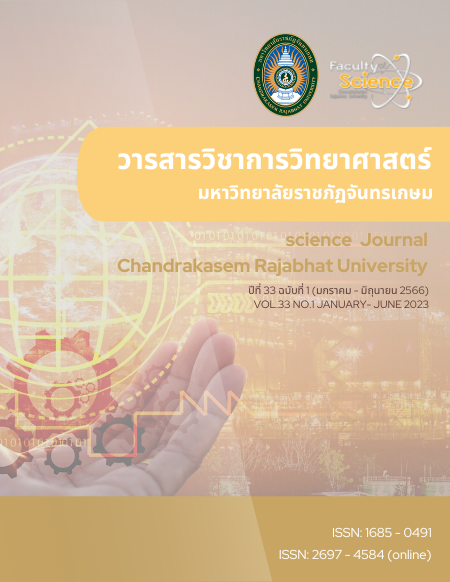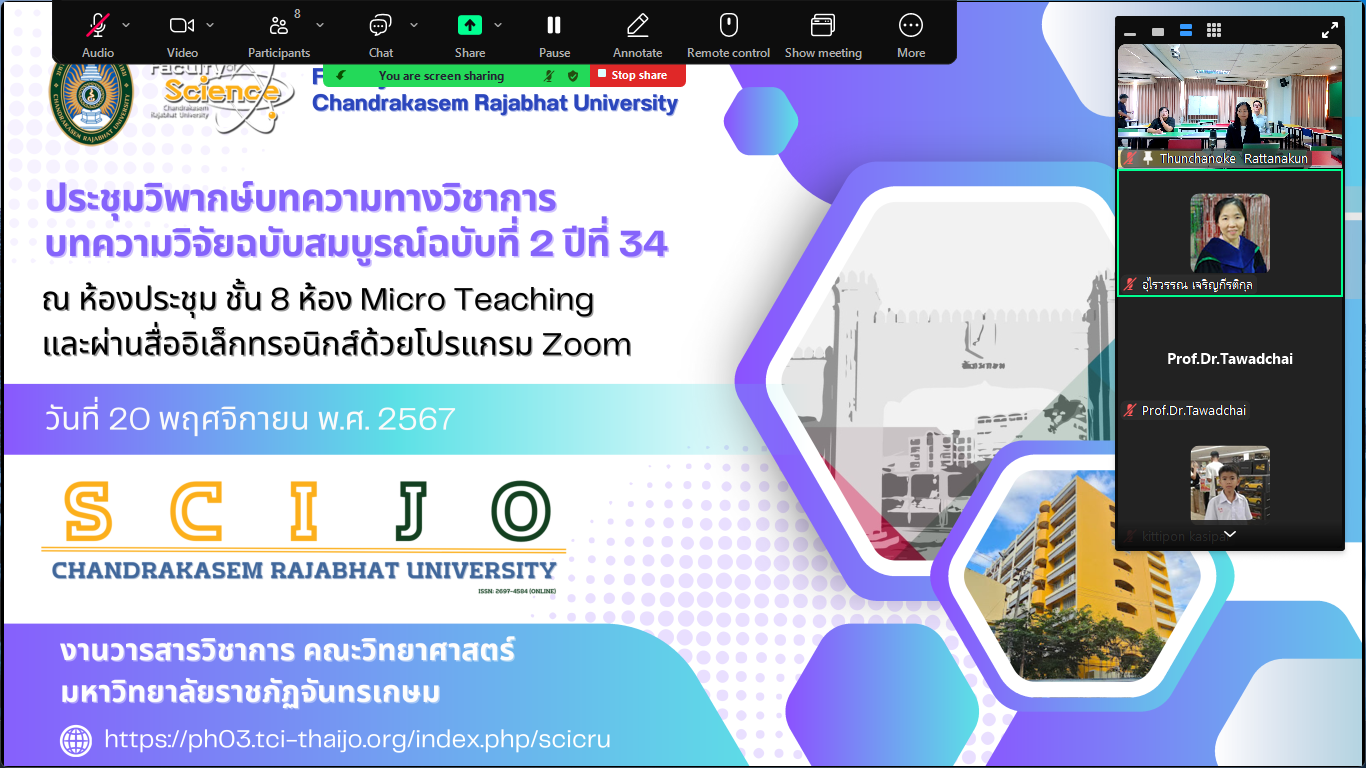BIOPOLYOL PREPARATION from NATURAL RUBBER and WASTE RUBBER PRODUCT
Keywords:
natural rubber, waste rubber product, Oligomer, biopolyolAbstract
This research is interested in studying the effects of rubber waste types on the efficiency and feasibility of bio-polyol preparation. The materials selected for the study consisted of natural rubber, waste glove rubber, and waste tire rubber. Bio polyols are low molecular weight oligomers with hydroxyl groups at the end of the chain. The experiment was divided into 2 steps. Step 1: Prepare bio-carbonyl telechelic oligomers from natural rubber, waste glove rubber, and waste tire rubber. Step 2 was the preparation of bio-hydroxyl telechelic oligomers from bio-carbonyl telechelic oligomers. Carbonyl end group formation was examined and analyzed by FT-IR and
1H-NMR. It was found that natural rubber is more easily oxidized to the carbonyl end group than waste glove rubber and waste tire rubber, respectively. Proton signals can confirm carbonyl group formation at positions 2.1, 2.25–2.49, and 9.8 ppm, which are protons attached to carbonyl groups on both sides of the molecular chain. Molecular weights of all 3 types of bio-carbonyl telechelic oligomers ranged from 1,500–2,500 g/mol—successful preparation of bio-hydroxyl telechelic oligomers. Since no signal was found in the 2.1–2.5 ppm range, proton signals were found at 3.65 and 3.8 ppm instead, which are the positions of -CH2OH and -CHOH, respectively. The proton signal at 3.65 and 3.8 ppm confirms the formation of hydroxyl groups at the end of the chain. The molecular weight of bio-hydroxyl telechelic oligomers was 1,500–3,500 g/mol. The FT-IR functional group analysis showed the formation of carbonyl groups at the absorbance wave number 1,720 cm-1, and a change was observed. That shows the formation of hydroxyl groups at the absorbance band in the range of 3,325–3,500 cm-1.
References
Dahham, O. S., Noriman, N. Z., Ting, S. S., Omar, M. F., & Alakrach, A. M. (2015). Cure Characteristics, Tensile and Physical Properties of
Recycled Natural Rubber Latex Glove (NRL-G) Filled Acrylonitrile Butadiene Rubber. Applied Mechanics and Materials, 754-755, 693-
doi:10.4028/www.scientific.net/AMM.754-755.693
Dworakowska, S., Bogdal, D., & Ravasio, N. (2013). The role of catalysis in the synthesis of polyurethane foams based on renewable raw
materials. Catalysis Today, 223. doi:10.1016/j.cattod.2013.11.054
Jaratrotkamjorn, R., & Tanrattanakul, V. (2020). Bio-based flexible polyurethane foam synthesized from palm oil and natural rubber. Journal
of Applied Polymer Science, 137(43), 49310. doi:https://doi.org/10.1002/app.49310
Kébir, N., Morandi, G., Campistron, I., Laguerre, A., & Pilard, J.-F. (2005). Synthesis of well defined amino telechelic cis-1,4-oligoisoprenes from
carbonyl telechelic oligomers; first studies of their potentialities as polyurethane or polyurea materials precursors. Polymer, 46(18),
-6854. doi:https://doi.org/10.1016/j.polymer.2005.05.122
Ma, Y., Wang, S., Zhou, H., Hu, W., Polaczyk, P., & Huang, B. (2022). Recycled polyethylene and crumb rubber composites modified asphalt
with improved aging resistance and thermal stability. Journal of Cleaner Production, 334, 130102.
doi:https://doi.org/10.1016/j.jclepro.2021.130102
Panwiriyarat, W., Tanrattanakul, V., Pilard, J.-F., Pasetto, P., & Khaokong, C. (2013). Preparation and Properties of Bio-based Polyurethane
Containing Polycaprolactone and Natural Rubber. Journal of Polymers and the Environment, 21. doi:10.1007/s10924-012-0567-6
Rattanapan, S., Artchomphoo, J., Saijun, D., & Sungsee, P. (2021). Combination Effects of Calcium Carbonate and Crumb Rubber Fillers on the
Properties of Natural Rubber Latex Foams. Current Applied Science and Technology. https://doi.org/10.55003/CAST.2022.01.22.012
Rattanapan, S., Pasetto, P., Pilard, J.-F., & Tanrattanakul, V. (2016a). Polyurethane foams from oligomers derived from waste tire crumbs and
polycaprolactone diols. Journal of Applied Polymer Science, 133(47). doi:https://doi.org/10.1002/app.44251
Rattanapan, S., Pasetto, P., Pilard, J.-F., & Tanrattanakul, V. (2016b). Preparation and properties of bio-based polyurethane foams from
natural rubber and polycaprolactone diol. Journal of Polymer Research, 23(9), 182. doi:10.1007/s10965-016-1081-7
Ruamcharoen, J., Phetphaisit, C. W., & Ruamcharoen, P. (2022). Green rigid polyurethane foam from hydroxyl liquid natural rubbers as
macro-hydroxyl polyols. Journal of Cellular Plastics, 58(3), 555-568. doi:10.1177/0021955X221074405
Downloads
Published
How to Cite
Issue
Section
License
Copyright (c) 2023 Chandrakasem Rajabhat University

This work is licensed under a Creative Commons Attribution-NonCommercial-NoDerivatives 4.0 International License.
บทความที่ได้รับการตีพิมพ์เป็นลิขสิทธิ์ของมหาวิทยาลัยราชภัฏจันทรเกษม
ข้อความที่ปรากฎในบทความแต่ละเรื่องในวารสารวิชาการเล่มนี้เป็นความคิดเห็นส่วนตัวของผู้เขียนแต่ละท่าน ไม่เกี่ยวข้องกับมหาวิทยาลัยราชภัฏจันทรเกษม และคณาจารย์ท่านอื่นในมหาวิทยาลัยแต่อย่างใด ความรับผิดชอบองค์ประกอบทั้งหมดของบทความแต่ละเรื่องเป็นของผู้เขียนแต่ละท่าน หากมีความผิดพลาดใดๆ ผู้เขียนแต่ละท่านจะรับผิดชอบบทความของตัวเองแต่เพียงผู้เดียว




 For Author
For Author


